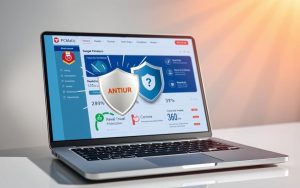Table of Contents
Cybersecurity for intellectual property is of utmost importance in today’s digital age. IP protection, data security, and information security are critical for businesses to safeguard their valuable assets.
Intellectual property theft poses a significant risk to businesses of all sizes. Whether it’s product designs, trade secrets, or confidential information, organizations must take proactive steps to identify and protect their intellectual property from cyber threats.
Implementing strong security policies and access control measures is crucial in preventing replication of products, trade secret theft, and unauthorized access to confidential information. Conducting a risk assessment helps organizations identify vulnerabilities and prioritize IP protection.
By prioritizing cybersecurity for intellectual property and implementing robust security measures, businesses can improve their overall cybersecurity posture and ensure the long-term integrity and profitability of their intellectual property assets.
The Importance of Intellectual Property
Intellectual property (IP) is a valuable asset for businesses, encompassing copyrights, patents, trademarks, and trade secrets. Protecting IP is crucial to prevent financial losses and damage to a company’s reputation. Effective intellectual property risk management and theft prevention measures are essential to safeguarding digital assets, ensuring copyright protection, and securing patent security.
IP theft can result in significant financial losses and compromise the exclusivity of innovative products and inventions. Therefore, businesses must prioritize the protection of their valuable IP assets. This includes implementing robust security systems, digital asset security measures, and theft prevention strategies.
Copyright protection plays a vital role in maintaining the exclusivity and profitability of creative works, while patent security safeguards innovative products and technologies. By prioritizing IP protection and implementing appropriate measures, businesses can mitigate the risk of IP theft and safeguard their intellectual property assets for long-term success.
Table: Importance of Intellectual Property Security
| Key Considerations | Key Strategies |
|---|---|
| Implementing robust security systems | Utilize advanced encryption methods to safeguard digital assets. |
| Digital asset security measures | Implement multi-factor authentication and access controls to restrict unauthorized access. |
| Theft prevention strategies | Establish comprehensive policies and procedures to protect sensitive information and prevent IP theft. |
| Copyright protection | Register creative works and enforce copyright laws to maintain exclusivity. |
| Patent security | File patents for innovative products and technologies to ensure legal protection and prevent unauthorized use. |
Cyber Threats to Intellectual Property
In today’s digital landscape, intellectual property faces significant threats from cybercriminals. These malicious actors actively target valuable intellectual property, seeking to steal and exploit it for financial gain. Intellectual property theft, including patent infringement and trade secret theft, poses substantial risks to businesses worldwide. To protect intellectual property from these cyber threats, organizations must adopt proactive measures to prevent and detect data breaches and unauthorized access.
Cyber threat prevention is crucial in safeguarding intellectual property. Implementing robust security measures, such as firewalls, encryption, and multi-factor authentication, can help protect sensitive information from unauthorized access. Regular monitoring of network traffic and implementing strong email security protocols can prevent the illicit movement of intellectual property. Organizations should also invest in data loss prevention tools and threat intelligence systems to detect and mitigate cyber threats before they cause significant damage.

In addition to external threats, organizations must also be vigilant about internal risks to intellectual property. Employee awareness and training programs are essential in educating staff about the importance of intellectual property protection and the risks of data breaches. Implementing access controls and enforcing non-disclosure agreements can help prevent unauthorized access and leakage of sensitive information. By taking a holistic approach to cybersecurity, organizations can effectively mitigate cyber threats and protect their intellectual property.
Protecting Intellectual Property from Internal Threats
Internal threats pose a significant risk to intellectual property. Employees can inadvertently or intentionally leak confidential information, making businesses vulnerable to intellectual property theft. It is crucial to educate employees on the importance of intellectual property, establish strong device use policies, and have employees sign non-disclosure or IP agreements. Implementing access control measures and monitoring network traffic can help prevent unauthorized access to intellectual property. Regular employee training and awareness programs can mitigate the risks associated with internal threats.
The Role of Employee Training and Non-Disclosure Agreements
One of the key steps in protecting intellectual property from internal threats is providing comprehensive employee training. By educating employees on the value of intellectual property and the potential consequences of unauthorized disclosure, businesses can raise awareness and promote a culture of security. Training programs should cover topics such as identifying sensitive information, understanding the importance of non-disclosure agreements, and recognizing signs of potential intellectual property theft. Additionally, requiring employees to sign non-disclosure agreements can legally bind them to protect intellectual property and serve as a deterrent against unauthorized access or leaks.
Implementing Access Control Measures and Network Monitoring
Another crucial aspect of internal threat prevention is implementing access control measures and monitoring network traffic. By restricting access to intellectual property only to authorized personnel, businesses can minimize the risk of unauthorized disclosure or theft. This can be achieved through the use of role-based access control systems and multi-factor authentication. Additionally, monitoring network traffic can help detect any suspicious activities or attempts to access sensitive information. By closely monitoring and analyzing network logs, businesses can quickly identify and respond to potential threats before they can cause significant harm.
Regular Employee Training and Awareness Programs
Regular employee training and awareness programs play a vital role in mitigating the risks associated with internal threats. By keeping employees updated on the latest security practices, emerging threats, and the importance of safeguarding intellectual property, businesses can empower their workforce to be proactive in protecting sensitive information. These programs can include interactive workshops, online courses, and informative newsletters or bulletins. By fostering a culture of security and continuous learning, businesses can significantly reduce the chances of internal threats compromising their intellectual property.
| Key Measures for Protecting Intellectual Property from Internal Threats | Benefits |
|---|---|
| Comprehensive employee training | – Increased awareness and understanding of the value of intellectual property – Recognition of potential threats and signs of intellectual property theft – Cultivation of a security-focused company culture |
| Non-disclosure agreements | – Legally binding employees to protect intellectual property – Deterrent against unauthorized access and leaks |
| Access control measures | – Restricting access to authorized personnel only – Minimizing the risk of unauthorized disclosure or theft |
| Network monitoring | – Detection of suspicious activities and attempts to access sensitive information – Timely response to potential threats |
| Regular training and awareness programs | – Empowerment of employees to be proactive in protecting intellectual property – Keeping employees updated on security practices and emerging threats |
Monitoring and Detecting Potential Intellectual Property Theft
In today’s digital landscape, organizations must remain vigilant in monitoring and detecting potential intellectual property (IP) theft. By leveraging cybersecurity technology and implementing robust detection and remediation strategies, businesses can protect their valuable IP assets from cyberattacks and unauthorized access.
One key tool for monitoring and detecting potential IP theft is data loss prevention (DLP) technology. DLP solutions can automatically identify and classify sensitive data, such as trade secrets, confidential documents, and proprietary information. These tools help organizations identify abnormal data movement or unauthorized access to sensitive files, allowing for timely intervention and prevention of intellectual property theft.
“Data loss prevention (DLP) technology is a crucial component of any comprehensive IP protection strategy. These tools help organizations identify abnormal data movement or unauthorized access to sensitive files, allowing for timely intervention and prevention of intellectual property theft.”
In addition to DLP technology, organizations should also implement robust cybersecurity protocols and monitoring systems. By regularly auditing security controls, conducting vulnerability assessments, and using threat intelligence platforms, businesses can stay one step ahead of potential cyber threats. These measures enable the detection of suspicious activities, such as unauthorized access attempts or data exfiltration, which may indicate an ongoing IP theft attempt.
It is important to note that monitoring and detection should be coupled with effective remediation strategies. This includes isolating compromised systems, blocking unauthorized access, and restoring any stolen intellectual property. Organizations should also establish incident response plans to ensure a swift and coordinated response in the event of an IP theft incident.
Overall, monitoring and detecting potential intellectual property theft is crucial for protecting valuable IP assets. By leveraging cybersecurity technology, implementing robust detection and remediation strategies, and staying vigilant against evolving cyber threats, organizations can safeguard their intellectual property and maintain a strong competitive edge in the market.

| Cybersecurity Technology | Detection and Remediation |
|---|---|
| Data Loss Prevention (DLP) | Identify and classify sensitive data, detect abnormal data movement |
| Cybersecurity Protocols | Regularly audit security controls, conduct vulnerability assessments |
| Threat Intelligence Platforms | Utilize threat intelligence to detect suspicious activities |
| Incident Response Planning | Establish swift and coordinated response strategies |
Tips for Intellectual Property Protection
Protecting intellectual property (IP) is crucial for businesses to maintain their competitive edge and ensure long-term success. Implementing effective strategies for IP protection involves a combination of risk analysis, labeling, and physical and digital security measures.
One important aspect of IP protection is conducting a thorough risk analysis. By identifying potential threats and vulnerabilities, organizations can prioritize the protection of their most valuable assets. This analysis should include assessing the risk of cyber threats, internal breaches, and external espionage. Understanding the specific risks facing the organization will help in tailoring appropriate security measures.
Another key practice in IP protection is labeling. By clearly designating IP as confidential or proprietary, organizations raise awareness among employees and external stakeholders about the importance of safeguarding this valuable information. This labeling can be done through the use of watermarks, digital rights management tools, or physical marking on documents and prototypes.
Physical and digital security measures play a significant role in IP protection. Organizations should establish access control mechanisms to limit unauthorized access to sensitive information. This includes implementing strong passwords, encryption, and secure storage measures. Regularly updating software and systems is essential to address vulnerabilities and stay ahead of emerging threats.
Overall, ensuring effective IP protection requires a multi-faceted approach. By conducting risk analysis, labeling IP assets, and implementing robust physical and digital security measures, organizations can mitigate the risk of IP theft and safeguard their valuable intellectual property.
Protecting Crown Jewels from IP Theft
Large organizations can employ various resources and security measures to protect their intellectual property (IP) from theft. However, every organization, regardless of size, can take specific steps to mitigate the risk of IP theft. By implementing these strategies, companies can safeguard their most valuable assets and maintain a competitive edge. Some key measures to consider include:
Zero Trust Security
Implementing a zero trust security architecture can significantly enhance IP protection. This approach treats every device and user as potentially untrusted, requiring continuous verification and authentication. By adopting this mindset, organizations can prevent unauthorized access to IP assets and ensure that only authorized individuals can access sensitive information.
Inventorying IP Assets
Creating an inventory of all IP assets is crucial for effective IP protection. This involves identifying and documenting patents, trademarks, copyrights, trade secrets, and any other forms of IP that the organization possesses. Having a comprehensive understanding of the organization’s IP landscape enables better prioritization of resources and the implementation of appropriate security measures.
IP Management Software
Utilizing IP management software can streamline IP protection efforts. This software enables organizations to centralize and manage their IP assets, track licensing agreements, monitor potential infringements, and enforce IP rights. By utilizing these tools, organizations can ensure proper documentation, traceability, and proactive management of their IP assets.
| IP Protection Strategies | Benefits |
|---|---|
| Implementing zero trust security | Enhanced authentication and access control, reducing the risk of unauthorized IP access and theft. |
| Inventorying IP assets | Improved visibility and understanding of the organization’s IP portfolio, facilitating effective resource allocation. |
| Utilizing IP management software | Streamlined management and monitoring of IP assets, ensuring proactive protection and enforcement. |
By employing these IP protection resources, embracing zero trust security, conducting thorough IP inventories, and utilizing IP management software, organizations can significantly mitigate the risk of IP theft. Protecting the organization’s crown jewels ensures the long-term integrity, profitability, and competitive advantage of its intellectual property assets.

Counter-Intelligence Mindset for IP Protection
When it comes to protecting intellectual property, organizations need to adopt a counter-intelligence mindset. By thinking like a spy and anticipating potential vulnerabilities, businesses can implement effective countermeasures to safeguard their valuable assets.
One important aspect of a counter-intelligence approach is securing employee phone lists. These lists contain contact information for key personnel, making them a prime target for competitors or potential adversaries. By implementing strict controls on who can access and view these phone lists, organizations can minimize the risk of unauthorized disclosure.
“Thinking like a spy and considering how one would try to gather sensitive information can lead to effective countermeasures.”
Another crucial counter-intelligence measure is to shred documents containing sensitive information. This helps prevent unauthorized individuals from gaining access to confidential data through physical means. By disposing of sensitive documents properly, organizations can significantly reduce the risk of information leaks and IP theft.
In addition, organizations should control the information they release to regulatory agencies. By carefully evaluating the data shared with external bodies, businesses can ensure that they protect their intellectual property while meeting regulatory requirements. This requires a thorough understanding of the information that must be disclosed and the potential risks associated with it.
Adopting a counter-intelligence mindset requires collaboration between different corporate functions, such as legal, human resources, IT, and R&D. By establishing connections and communication channels between these departments, organizations can develop a comprehensive and robust strategy for intellectual property protection, further strengthening their corporate security.
Table: Counter-Intelligence Measures for IP Protection
| Counter-Intelligence Measure | Description |
|---|---|
| Secure Employee Phone Lists | Implement strict controls on access and viewing of employee phone lists to prevent unauthorized disclosure. |
| Shred Sensitive Documents | Dispose of documents containing sensitive information properly to minimize the risk of physical data breaches. |
| Control Information Shared with Regulatory Agencies | Evaluate the data shared with external bodies to protect intellectual property while meeting regulatory requirements. |
| Collaboration between Corporate Functions | Establish connections and communication channels between legal, human resources, IT, and R&D to develop a comprehensive IP protection strategy. |
Thinking Globally for IP Protection
When it comes to intellectual property (IP) protection, organizations must consider the international business risks associated with operating in different parts of the world. The country perception index, which measures the levels of corruption in various countries, is a crucial factor to consider. Some countries have a reputation for encouraging or tolerating industrial espionage, making IP more vulnerable. Furthermore, corruption can weaken legal protections and enforcement actions, posing additional risks to IP. Therefore, it is essential for organizations to understand the local regulatory environment and implement stringent security measures to mitigate the risks associated with global IP protection.
Protecting intellectual property on a global scale requires comprehensive strategies. It is necessary to evaluate the risks of doing business in different countries and assess their commitment to IP protection. Understanding the legal frameworks and enforcement mechanisms in each jurisdiction is crucial. Additionally, organizations should establish strong relationships with local partners and collaborate with government agencies to ensure the effective protection of IP. Implementing robust physical and digital security measures and encrypting sensitive information are vital to safeguarding IP assets in international collaborations.
To illustrate the risks associated with global IP protection, the table below showcases the corruption perception index of selected countries:
| Country | Corruption Perception Index |
|---|---|
| Denmark | 88 |
| United Kingdom | 77 |
| United States | 67 |
| China | 42 |
| Russia | 28 |
| North Korea | 14 |
Based on the corruption perception index, countries like Denmark and the United Kingdom have a higher perception of integrity and transparency, making them relatively safer for IP protection. On the other hand, countries with lower scores, such as China, Russia, and North Korea, may pose higher risks of IP theft due to their perceived levels of corruption. It is crucial for organizations to consider these factors when expanding their operations globally and take appropriate measures to mitigate the associated risks.
How IP Spies and Thieves Operate
When it comes to protecting intellectual property, organizations must be aware of the tactics used by IP spies and thieves. These individuals exploit various opportunities, including lax security measures and information leaks, to gather valuable information from companies. Understanding their tactics can help organizations bolster their IP protection strategies.
Competitive Intelligence: IP spies often engage in competitive intelligence activities to gain a competitive edge. They gather information on product development, marketing strategies, and other proprietary data to stay ahead of the competition. Using this information, they can replicate products or services, eroding a company’s market position.
Lax Security: Weak security protocols provide an open invitation for IP thieves. They take advantage of outdated software, unencrypted data, and poor access controls to breach systems and steal valuable intellectual property. Organizations must prioritize robust security measures, including regular software updates, strong encryption methods, and strict access controls, to prevent unauthorized access to sensitive information.
Information Leaks: IP thieves actively seek out information leaks within organizations. This can include monitoring public announcements of patent filings, analyzing job listings that reveal R&D facilities, or gathering information shared by employees on online forums and bulletin boards. Organizations must educate their employees about the importance of confidentiality and implement measures to prevent unintentional information leaks.
By understanding the tactics employed by IP spies and thieves, organizations can implement effective IP protection tactics. This includes strengthening security measures, conducting regular risk assessments, and educating employees on the importance of safeguarding intellectual property.
Table: Tactics Used by IP Spies and Thieves
| Tactic | Description |
|---|---|
| Competitive Intelligence | IP spies gather information on competitors’ products, marketing strategies, and proprietary data to gain a competitive edge. |
| Lax Security | IP thieves take advantage of weak security protocols, outdated software, and poor access controls to breach systems and steal valuable intellectual property. |
| Information Leaks | IP thieves actively seek out information leaks within organizations, including public announcements of patent filings and unintentional employee disclosures. |
Protecting intellectual property requires organizations to be proactive in identifying and mitigating risks. By staying vigilant and implementing robust security measures, businesses can safeguard their valuable intellectual property from the threats posed by IP spies and thieves.

Conclusion
Protecting intellectual property (IP) is paramount for organizations to maintain a strong cybersecurity posture. With the increasing threats from cybercriminals, it is crucial to implement a comprehensive strategy that includes risk analysis, education and training, physical and digital security measures, monitoring and detection tools. By prioritizing IP security, businesses can safeguard their valuable assets and ensure long-term integrity and profitability.
The importance of IP security cannot be underestimated. IP theft can lead to significant financial losses and reputational damage. By conducting regular risk analysis, organizations can identify their most valuable assets and allocate resources effectively to protect them. Educating employees on the importance of IP protection and implementing strict device use policies are critical steps in mitigating internal threats.
To stay ahead of cyber threats, businesses must constantly monitor and detect potential IP theft. Utilizing advanced cybersecurity technology, such as data loss prevention tools and threat intelligence systems, can help organizations identify and respond to cyberattacks effectively. Strong encryption measures and robust cybersecurity protocols are essential in creating a secure environment for intellectual property.
In conclusion, organizations need to take a proactive approach to IP security. By implementing best practices, such as risk analysis, education and training, physical and digital security measures, monitoring and detection tools, and a strong cybersecurity posture, businesses can effectively protect their intellectual property assets and safeguard their competitive advantage in the digital age.
FAQ
What is intellectual property?
Intellectual property refers to copyrights, patents, trademarks, and trade secrets that a business possesses. It includes valuable assets such as product designs, formulas, beta features, employee training documents, and customer/client lists.
Why is intellectual property protection important?
Intellectual property theft can lead to financial losses and damage to a company’s reputation. It is essential for businesses to prioritize the protection of their intellectual property through risk management strategies, theft prevention measures, and robust security systems for digital assets.
What are the cyber threats to intellectual property?
Cybercriminals can steal valuable intellectual property, such as patented innovations and trade secrets, and sell it to competitors or state-sponsored groups seeking economic or strategic advantages. Intellectual property theft costs the global economy billions of dollars annually.
How can businesses protect intellectual property from internal threats?
Educating employees on the importance of intellectual property, establishing strong device use policies, having employees sign non-disclosure or IP agreements, implementing access control measures, and monitoring network traffic can help prevent unauthorized access to intellectual property.
How can organizations monitor and detect potential intellectual property theft?
By utilizing cybersecurity technology, such as data loss prevention tools and threat intelligence systems, organizations can identify and respond to cyberattacks that put intellectual property at risk. Implementing strong encryption measures, restricting unauthorized access, and establishing robust cybersecurity protocols are also effective ways to monitor and detect potential intellectual property theft.
What tips can help enhance intellectual property protection?
Conducting a risk analysis, prioritizing valuable intellectual property assets, labeling intellectual property as confidential or proprietary, implementing physical and digital security measures, and regularly educating employees on intellectual property and potential theft are crucial in enhancing protection.
How can organizations protect their intellectual property resources?
Organizations can protect their intellectual property resources by inventorying them, mapping their locations, implementing policies and technologies to prevent IP theft, utilizing IP management software, controlling access to IP, and educating employees and partners on their role in IP protection.
What is the counter-intelligence mindset for IP protection?
Adopting a counter-intelligence mindset involves thinking like a spy and considering how one would try to gather sensitive information. Establishing robust security measures, raising employee awareness, and utilizing tools such as data loss prevention and encryption help protect against IP theft.
How can organizations think globally for IP protection?
Organizations can think globally for IP protection by understanding the local regulatory environment, protecting sensitive information during international collaborations, implementing stringent security measures, and evaluating the risks of doing business in different parts of the world.
How do IP spies and thieves operate?
IP spies and thieves exploit lax security and information leaks to gather valuable information from companies. Salespeople showcasing upcoming products, job listings revealing R&D facilities, suppliers boasting about sales on their websites, and public announcements of patent filings are all opportunities for IP theft. Employees unknowingly contributing to IP leaks through online forums and bulletin boards can also be a significant risk.
What is the importance of IP security in overall cybersecurity posture?
IP security is a critical aspect of cybersecurity for organizations. Safeguarding IP from cyber threats, internal breaches, and external espionage requires a comprehensive strategy that includes risk analysis, education and training, physical and digital security measures, monitoring and detection tools, and a strong cybersecurity posture.
Source Links
- https://www.csoonline.com/article/544738/intellectual-property-protection-10-tips-to-keep-ip-safe.html
- https://www.mimecast.com/blog/intellectual-property-protection-against-ip-theft/
- https://carbidesecure.com/resources/protecting-your-intellectual-property/









